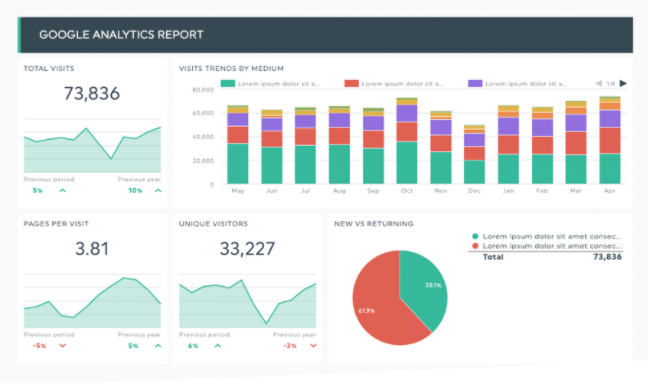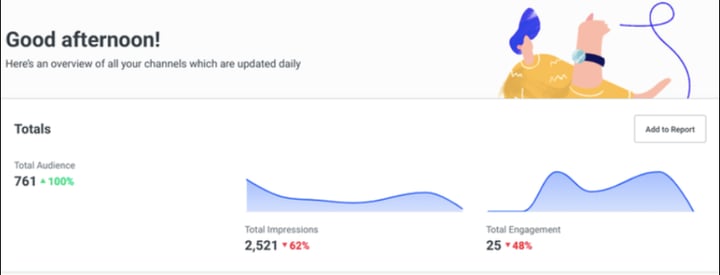-
 Written by Ahmad Benny
Written by Ahmad BennyLondon-born lover of technology, e-commerce, and digital marketing.
While web analytics can provide a glimpse into the performance of your online shop, it's only one part of the puzzle.
Your pursuit of additional insight should never stop. After all, each new insight about your customers and sales funnel can help you take your marketing a notch higher.
Integrating data from digital marketing analytics tools with your web analytics can help you glean a more accurate and holistic picture of the impact of your marketing activities.
Keep reading to learn how this powerful duo can work together to improve your marketing campaigns.
Why should you pay attention to digital marketing analytics?
Digital analytics provides information on how customers are interacting with your brand online. This analysis covers all the digital channels on which your brand is active. These channels might include:
- social media platforms, such as Facebook, Instagram, or LinkedIn
- online display and search ads
- email marketing
- SEO tactics
- partner and affiliate marketing campaigns
Marketing analytics in the digital space include measuring customer behavior beyond clicks. By factoring digital marketing analytics into your data analysis strategies, you can gain a deeper understanding of your target audience. This knowledge can help you better adjust both your marketing efforts and your products to their needs.
Web Analytics Vs Digital Marketing Analytics
Web analytics and digital marketing analytics are two related but fundamentally different things. Website analytics lets you understand:
- How do visitors use your site?
- What devices do they use to access your website?
- How long do they stay?
- Where do they move around on the webpage?
- What pages do they browse the most?

It measures, analyzes, and reports on the effectiveness of your website. Digital marketing analytics, on the other hand, gives you insights into your campaigns, helping you test and refine your efforts to maximize results. Web analytics also falls under this umbrella term, as it analyzes the performance of a digital data source, your website.
The digital landscape is ever-changing, and digital marketing analytics helps you keep up to date with your audience's habits and preferences. With digital marketing analytics, you can track:
- your users' behavior on your website and across different channels
- the effectiveness of your marketing campaigns, and how they interact with each other
When you're just starting, web analytics may be enough for you. But as your company grows and gains visibility, you'll want to supplement these metrics with data from other sources to get a better sense of how your campaigns are faring.
Meet the Analytics Dream Team
Now that we've covered the basics, let's see how digital marketing analytics goes hand-in-hand with web analytics to form a productive team.
Digital marketing analytics and web analytics work together to keep a business on the path to success. Just like in football, where teamwork is essential to winning, both analytics play crucial roles in keeping your business on top of its game. If the wide receiver doesn't know what route to run, or if the quarterback can't throw or catch the ball, neither will be successful on the field. In the same way, web analytics and digital marketing analytics need to communicate and collaborate in order to produce meaningful insights.
To supplement web analytics with digital marketing analytics, here are the steps you need to follow:
Ensure your website is set up with web analytics
Make sure you have a good web analytics tool in place. It's only with the use of web analytics tools that you'll be able to understand user behavior on your site. Armed with this data, you can make informed decisions about what needs improving on your website.
Discover what web analytics can't tell you about your marketing strategy
Learn what your web statistics do not reveal about your overall marketing plan. Once you notice rifts in your marketing data, it becomes easier to configure the right analytics tool to fill those holes. For example, if you want to track how well your social media campaigns are doing, you can use a tool like Buffer that measures the efficiency of these campaigns.

Compute the necessary parameters to your analytics report
To make something out of all the information you've pulled, you need to sync different types of data with each other. Then, aggregate and transfer this data into a single dashboard. You can accomplish this manually or with the help of various tools. Voila! Now you have a comprehensive view of your overall marketing plan.
Digital Marketing Metrics to Monitor
When you're just getting started with digital marketing analytics, the amount of information you have at your disposal can be overwhelming. There are a lot of numbers to track and a lot of metrics to keep an eye on. You can easily get lost in a sea of statistics.
So it's vital to prioritize the metrics that are most valuable to your business. That way, you can correctly forecast performance, avoid pitfalls, and take advantage of opportunities. Here are a few digital marketing metrics to consider:
Traffic
Traffic is probably the most frequently cited metric in marketing reports. But what becomes of all the data? How could it be used to your benefit? The first step is to break down traffic by channel. This helps you identify where your leads are coming from and what channels are the most effective.
Once you have done that, you can easily see which channels are delivering your most important audience and which ones you need to work on. The main traffic slices are:
- Organic visitors. People who have searched for a product or service, and found your website in the search engine results. Organic traffic is one of the most valuable kinds of traffic you can get since it directly reflects the success of your SEO strategy.
- Direct visitors. Users who came to your website by entering your URL directly into the address bar or bookmarked your site to return later.
- Social visitors. Users that arrive at your site from a social media post or content you shared.
- Referrals. These are visitors directed to a business's website from another site.
- Paid traffic. This is any person that was brought into your store by an ad or promotional piece of content.
Conversions
Converting visitors into customers is the ultimate goal of any business. Tracking conversions gives you a bird's-eye view of how visitors engage with your website before converting into a customer. This information is priceless for any business, as it allows you to identify which marketing efforts are working. You can then take this information and use it to guide future marketing decisions.
Engagement
The hallmark of a successful social media or content marketing campaign is an engaged following, not one that is merely big. Without engagement from your target audience, your social media profiles are just dead spaces on the web. So, the best way to measure the effectiveness of your internet presence is by looking at engagement, rather than brand reach or follower count. Visitors who engage with your brand online have a higher chance of becoming customers.
Website loading time
Kissmetrics reports that 40 percent of users will walk away from a website that takes more than three seconds to load. Do you know how long three seconds are? That's the amount of time it takes to read the previous sentence — and we're talking about full comprehension here, not scanning.
If your website takes forever to load, you can kiss an awful lot of potential sales goodbye. There's no room for slow servers in today's digital space. A major part of providing exemplary customer service is making sure that your website is not only personalized but also optimized.
Click-Through Rate (CTR)
The click-through rate is one of the most important metrics that marketers and advertisers use to gauge the value of a campaign. It measures the relevance of your content to your audience. A low click-through rate could mean that your content is either trivial or boring.
No matter how great your products are, you can't expect to sell them if people don't notice you. If customers aren't engaged with the content that you share or the ads that you run, then they won't be clicking on them — and, as a result, your sales will be suffering.
Bounce Rate
Bounce rate is a powerful digital marketing analytic that can help businesses understand which pages on their site are driving customers to take action and which ones are sending them running in the opposite direction. This number tells you whether visitors find your website useful, interesting, or engaging enough to continue with their browsing. By knowing this, you can target those areas where you need to make changes.
You can't improve what you don't assess
Not all analytics are created equally. The data that tells the whole story is often scattered across several channels (read more about what data storytelling is here). To see the bigger picture, it's critical to combine this data before drawing any conclusions. That's why examining web and digital marketing metrics in tandem is the best way to get a feel for what you're doing right and where you can improve. By doing so, you can see how all your efforts across marketing channels are coming along, which will ultimately allow you to tweak and refine your marketing strategy.
-
 Written by Ahmad Benny
Written by Ahmad BennyLondon-born lover of technology, e-commerce, and digital marketing.